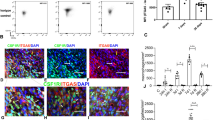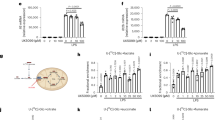Abstract
Understanding cellular response to environmental stress has broad implications for human disease. AMP-activated protein kinase (AMPK) orchestrates the regulation of energy-generating and -consuming pathways, and protects the heart against ischaemic injury and apoptosis1. A role for circulating hormones such as adiponectin2 and leptin3 in the activation of AMPK has received recent attention. Whether local autocrine and paracrine factors within target organs such as the heart modulate AMPK is unknown. Here we show that macrophage migration inhibitory factor (MIF), an upstream regulator of inflammation4, is released in the ischaemic heart, where it stimulates AMPK activation through CD74, promotes glucose uptake and protects the heart during ischaemia-reperfusion injury. Germline deletion of the Mif gene impairs ischaemic AMPK signalling in the mouse heart. Human fibroblasts with a low-activity MIF promoter polymorphism5 have diminished MIF release and AMPK activation during hypoxia. Thus, MIF modulates the activation of the cardioprotective AMPK pathway during ischaemia, functionally linking inflammation and metabolism in the heart. We anticipate that genetic variation in MIF expression may impact on the response of the human heart to ischaemia by the AMPK pathway, and that diagnostic MIF genotyping might predict risk in patients with coronary artery disease.
This is a preview of subscription content, access via your institution
Access options
Subscribe to this journal
Receive 51 print issues and online access
$199.00 per year
only $3.90 per issue
Buy this article
- Purchase on Springer Link
- Instant access to full article PDF
Prices may be subject to local taxes which are calculated during checkout




Similar content being viewed by others
Accession codes
References
Russell, R. R. et al. AMP-activated protein kinase mediates ischemic glucose uptake and prevents postischemic cardiac dysfunction, apoptosis, and injury. J. Clin. Invest. 114, 495–503 (2004)
Shibata, R. et al. Adiponectin protects against myocardial ischemia-reperfusion injury through AMPK- and COX-2-dependent mechanisms. Nature Med. 11, 1096–1103 (2005)
Minokoshi, Y. et al. Leptin stimulates fatty-acid oxidation by activating AMP-activated protein kinase. Nature 415, 339–343 (2002)
Bernhagen, J. et al. MIF is a pituitary-derived cytokine that potentiates lethal endotoxaemia. Nature 365, 756–759 (1993)
Baugh, J. A. et al. A functional promoter polymorphism in the macrophage migration inhibitory factor (MIF) gene associated with disease severity in rheumatoid arthritis. Genes Immun. 3, 170–176 (2002)
Calandra, T. et al. MIF as a glucocorticoid-induced modulator of cytokine production. Nature 377, 68–71 (1995)
Calandra, T., Bernhagen, J., Mitchell, R. A. & Bucala, R. The macrophage is an important and previously unrecognized source of macrophage migration inhibitory factor. J. Exp. Med. 179, 1895–1902 (1994)
Burger-Kentischer, A. et al. Expression of macrophage migration inhibitory factor in different stages of human atherosclerosis. Circulation 105, 1561–1566 (2002)
Willis, M. S. et al. Macrophage migration inhibitory factor mediates late cardiac dysfunction after burn injury. Am. J. Physiol. Heart Circ. Physiol. 288, H795–H804 (2005)
Bernhagen, J. et al. MIF is a noncognate ligand of CXC chemokine receptors in inflammatory and atherogenic cell recruitment. Nature Med. 13, 587–596 (2007)
Mizue, Y. et al. Role for macrophage migration inhibitory factor in asthma. Proc. Natl Acad. Sci. USA 102, 14410–14415 (2005)
Donnelly, S. C. et al. Regulatory role for macrophage migration inhibitory factor in acute respiratory distress syndrome. Nature Med. 3, 320–323 (1997)
Mitchell, R. A., Metz, C. N., Peng, T. & Bucala, R. Sustained mitogen-activated protein kinase (MAPK) and cytoplasmic phospholipase A2 activation by macrophage migration inhibitory factor (MIF). Regulatory role in cell proliferation and glucocorticoid action. J. Biol. Chem. 274, 18100–18106 (1999)
Leng, L. et al. MIF signal transduction initiated by binding to CD74. J. Exp. Med. 197, 1467–1476 (2003)
Shi, X. et al. CD44 is the signaling component of the macrophage migration inhibitory factor-CD74 receptor complex. Immunity 25, 595–606 (2006)
Benigni, F. et al. The proinflammatory mediator macrophage migration inhibitory factor induces glucose catabolism in muscle. J. Clin. Invest. 106, 1291–1300 (2000)
Scott, J. W. et al. CBS domains form energy-sensing modules whose binding of adenosine ligands is disrupted by disease mutations. J. Clin. Invest. 113, 274–284 (2004)
Sakamoto, K. et al. Deficiency of LKB1 in heart prevents ischemia-mediated activation of AMPKα2 but not AMPKα1. Am. J. Physiol. Endocrinol. Metab. 290, E780–E788 (2006)
Hawley, S. A. et al. Calmodulin-dependent protein kinase kinase-β is an alternative upstream kinase for AMP-activated protein kinase. Cell Metab. 2, 9–19 (2005)
Marsin, A. S. et al. Phosphorylation and activation of heart PFK-2 by AMPK has a role in the stimulation of glycolysis during ischaemia. Curr. Biol. 10, 1247–1255 (2000)
Russell, R. R., Bergeron, R., Shulman, G. I. & Young, L. H. Translocation of myocardial GLUT-4 and increased glucose uptake through activation of AMPK by AICAR. Am. J. Physiol. 277, H643–H649 (1999)
Xing, Y. et al. Glucose metabolism and energy homeostasis in mouse hearts overexpressing dominant negative α2 subunit of AMP-activated protein kinase. J. Biol. Chem. 278, 28372–28377 (2003)
Shibata, R. et al. Adiponectin-mediated modulation of hypertrophic signals in the heart. Nature Med. 10, 1384–1389 (2004)
Takahashi, M. et al. Macrophage migration inhibitory factor as a redox-sensitive cytokine in cardiac myocytes. Cardiovasc. Res. 52, 438–445 (2001)
Bozza, M. et al. Targeted disruption of migration inhibitory factor gene reveals its critical role in sepsis. J. Exp. Med. 189, 341–346 (1999)
Gollob, M. H. et al. Identification of a gene responsible for familial Wolff–Parkinson–White syndrome. N. Engl. J. Med. 344, 1823–1831 (2001)
Plant, B. J. et al. Cystic fibrosis, disease severity, and a macrophage migration inhibitory factor polymorphism. Am. J. Respir. Crit. Care Med. 172, 1412–1415 (2005)
Zhong, X. B. et al. Simultaneous detection of microsatellite repeats and SNPs in the macrophage migration inhibitory factor (MIF) gene by thin-film biosensor chips and application to rural field studies. Nucleic Acids Res. 33, e121 (2005)
Sukhodub, A. et al. AMP-activated protein kinase mediates preconditioning in cardiomyocytes by regulating activity and trafficking of sarcolemmal ATP-sensitive K+ channels. J. Cell. Physiol. 210, 224–236 (2007)
Bernhagen, J. et al. Purification, bioactivity, and secondary structure analysis of mouse and human macrophage migration inhibitory factor (MIF). Biochemistry 33, 14144–14155 (1994)
Li, J. et al. Role of the nitric oxide pathway in AMPK-mediated glucose uptake and GLUT4 translocation in heart muscle. Am. J. Physiol. 287, E834–E841 (2004)
Coven, D. L. et al. Physiological role of AMP-activated protein kinase in the heart: graded activation during exercise. Am. J. Physiol. 285, E629–E636 (2003)
Acknowledgements
This work was supported by the US Public Health Service. The authors wish to thank K. Kevill and J. Hu for technical assistance, and G. Holman, S. Cushman and A. Edelman for providing reagents.
Author Contributions E.J.M. and J.L. each contributed to the experimental work, project planning, data analysis and writing of the manuscript. L.L. contributed to the experimental work and project planning. C.M. contributed to reagent development, validation and preparation. T.A. made the initial observation of MIF induction of AMPK phosphorylation. L.H.Y. and R.B. contributed to the project planning, data analysis and writing of the manuscript. L.H.Y. and R.B. were co-contributing senior authors.
Author information
Authors and Affiliations
Corresponding author
Ethics declarations
Competing interests
Yale University has applied for a patent describing the therapeutic use of MIF agonism and AMPK activation. R.B. is an inventor on a patent for MIF genotyping.
Supplementary information
Supplementary Information
The file contains Supplementary Figures 1-5 with Legends and additional references. (PDF 1866 kb)
Rights and permissions
About this article
Cite this article
Miller, E., Li, J., Leng, L. et al. Macrophage migration inhibitory factor stimulates AMP-activated protein kinase in the ischaemic heart. Nature 451, 578–582 (2008). https://doi.org/10.1038/nature06504
Received:
Accepted:
Issue Date:
DOI: https://doi.org/10.1038/nature06504
This article is cited by
-
Intermittent fasting activates macrophage migration inhibitory factor and alleviates high-fat diet-induced nonalcoholic fatty liver disease
Scientific Reports (2023)
-
Metformin confers longitudinal cardiac protection by preserving mitochondrial homeostasis following myocardial ischemia/reperfusion injury
European Journal of Nuclear Medicine and Molecular Imaging (2023)
-
Dexmedetomidine reduces myocardial ischemia-reperfusion injury in young mice through MIF/AMPK/GLUT4 axis
BMC Anesthesiology (2022)
-
Macrophage migration inhibitory factor (MIF) acetylation protects neurons from ischemic injury
Cell Death & Disease (2022)
-
Macrophage migration inhibitory factor facilitates the therapeutic efficacy of mesenchymal stem cells derived exosomes in acute myocardial infarction through upregulating miR-133a-3p
Journal of Nanobiotechnology (2021)
Comments
By submitting a comment you agree to abide by our Terms and Community Guidelines. If you find something abusive or that does not comply with our terms or guidelines please flag it as inappropriate.



